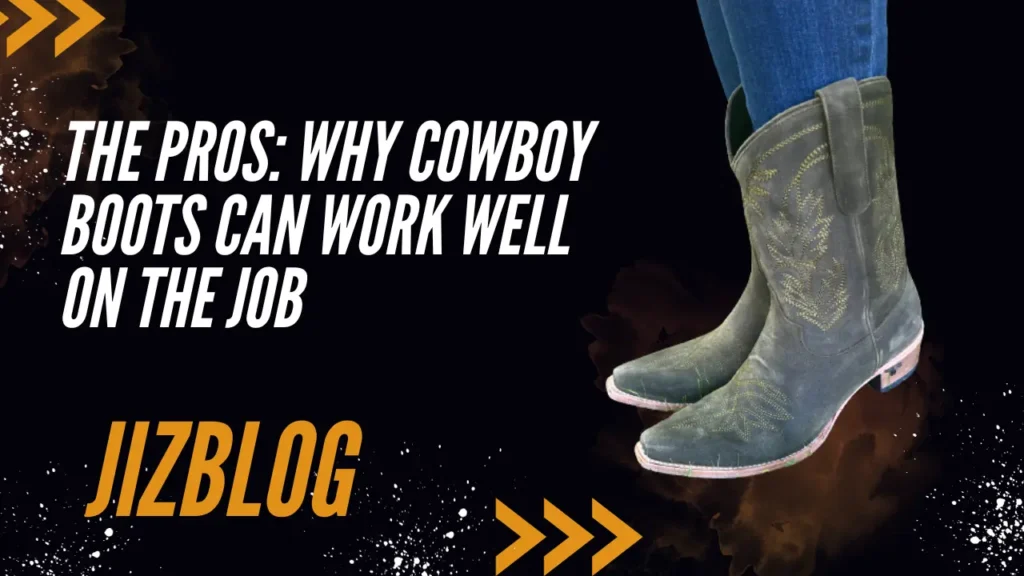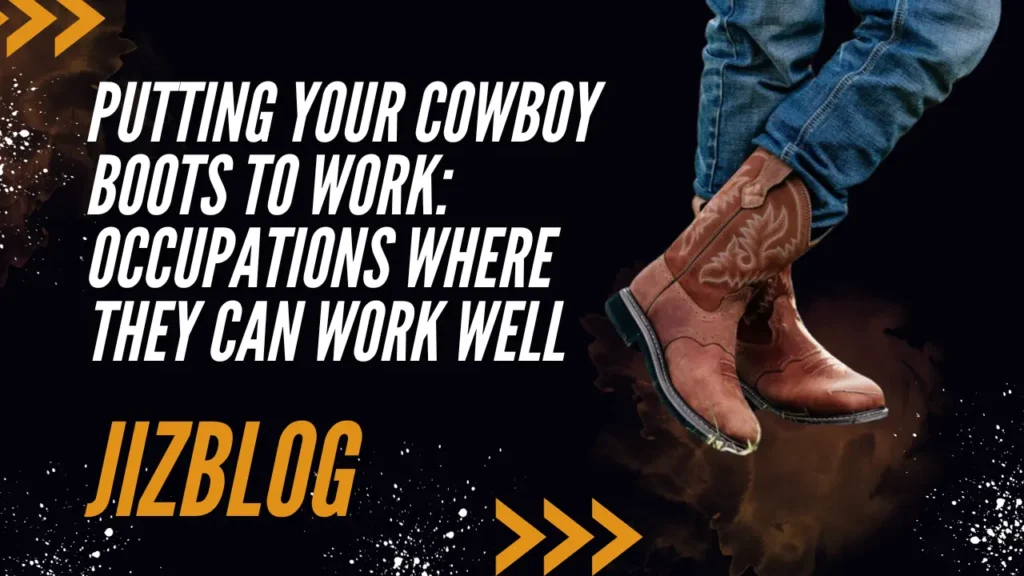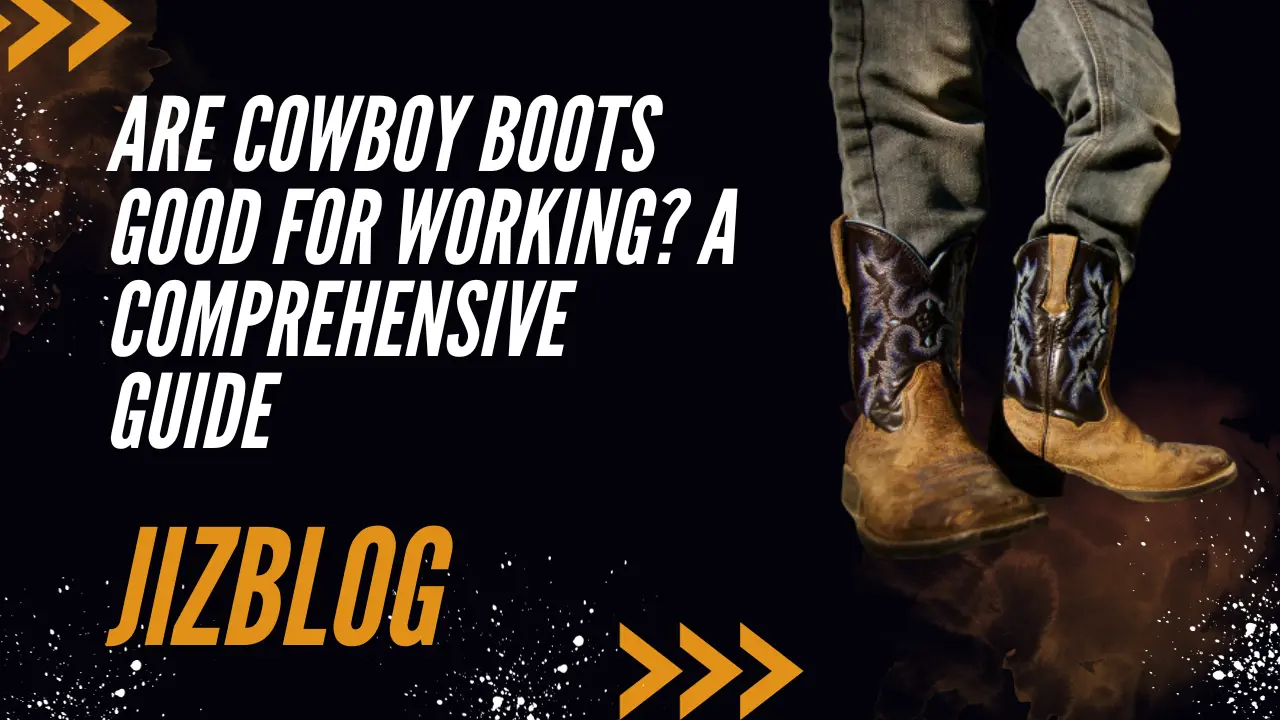Howdy, hardworking folks! Ever found yourself wondering are cowboy boots good for working? Well, let me tip my hat and share my two cents. I remember the day I swapped my regular work boots for a pair of rugged cowboy kicks—it felt like I’d upgraded my workday gear and embraced a touch of Western flair. In this post, we’re diving into the practicality of cowboy boots for the daily grind, exploring their durability, support, and style.
So, join me on this journey as we lasso the truth about why cowboy boots might just be the perfect companions for your next hardworking adventure:
A Brief History of Cowboy Boots
Before diving into form and function, let’s step back in time. Cowboy boots descended from riding boots worn by cattle herders in the American Southwest in the 1800s. The design provided protection when working with livestock, especially when riding horses.
Key features like a tall leather shaft, sturdy construction, and a pointed toe evolved to suit the lifestyles of cowboys and ranchers. As the Old West gave way to modern times, cowboy boots morphed into a fashion trend and cultural emblem rather than just practical footwear.
The Pros: Why Cowboy Boots Can Work Well on the Job

Now let’s examine why cowboy boots can be a smart choice for certain lines of work.
Durability
Cowboy boots stand up to heavy use thanks to their leather construction and sturdy soles. Most cowboy boots are crafted from high-quality full-grain leather, which develops a patina over time. Leather is rugged enough for farm work while being supple enough for comfort. Goatskin leather boots offer extra strength.
Protection
The shaft of a cowboy boot extends up the ankle, offering more coverage and support than a regular shoe. A tall, stiff leather shaft shields it from scrapes and bruises. It also prevents ankle rolls and twists, which is especially helpful when working on uneven terrain. Cowboy boots give your feet and ankles an extra layer of protection.
Traction
Cowboy boots are outfitted with textured rubber or leather soles with a defined heel. This heel/sole combo provides decent traction without a heavy lug sole. The angled design helps brace your stance for increased stability. Boots grant better footing than regular shoes when working outdoors.
Comfort
The structured leather shaft affixes the boot firmly to the foot for a secure feel. Padding around the collar enhances comfort. A cowboy boot should fit snugly, stabilizing the foot within. Go for a square-toe style, which allows your toes to move. The pitch of the heel sets your foot at a comfortable angle.
Style
For jobs that have a Western vibe, clients may expect employees to sport cowboy boots. Guest ranch hands, rodeo personnel, country band members, and horse trainers often don cowboy boots for function and style. Cowboy boots project a stylistic image in addition to their utility.
Table: Cowboy Boot Materials
| Material | Properties | Best Suited For |
|---|---|---|
| Full Grain Leather | Heavy-duty ranch/farm work | Heavy duty ranch/farm work |
| Goatskin Leather | Extra strong and rugged | Extreme conditions like oil rigs |
| Cow Suede | Soft and flexible | Office settings |
| Exotic Leathers | Ostrich, alligator, etc. – luxury aesthetic | Special occasions/formal events |
| Synthetic Leather | Vegan alternative; easy to clean | Light-duty indoor jobs |
Considerations When Wearing Cowboy Boots for Work
Cowboy boots have some drawbacks to weigh before making them your full-time work footwear.
Break-In Period
Brand-new cowboy boots tend to be stiff and unforgiving. The leather needs to soften and mold to your feet over an initial break-in period. This can take days or weeks of regular wear. Break them in gradually with thicker socks. Once broken in, cowboy boots become more comfortable.
Hot Weather
Leather boots can get hot and cause sweaty feet during the summer months. Opt for a lightweight leather or a mesh-lined boot to allow airflow. Change into cowboy boots once at your job site after driving in sandals or sneakers.
Cold/Wet Weather
Leather boots lack insulation, making them chilly in cold weather. Unlined styles won’t keep out rain or snow. For winter work, choose an insulated pair or add thermal insoles. Waterproof the leather with a spray treatment to repel moisture.
Sizing
Since cowboy boots only come in standard U.S. shoe sizes, getting an exact fit could be tricky. They should fit snugly around the heel and instep, with room to wiggle toes. Trying on different brands can help find your ideal size, as sizing varies. A custom-fit boot may be worthwhile.
Occupation Rules
Some jobs have regulations about footwear types permitted on the premises. Construction sites and factories often require steel-toe boots or other protective features absent in cowboy boots. Check your employer’s safety footwear policy before opting for cowboy boots.
Table: Cowboy Boot Style Features
| Style | Description | Benefits |
|---|---|---|
| riding heel | Angled heel, usually 1-2 inches tall | Stability, proper posture |
| roper heel | Low, wide heel; 1-1 1/2 inches tall | Easy walking |
| western heel | Tall, narrow heel; 2 inches or over | Riding comfort |
| round toe | Rounded toe shape | Room for toes to spread out |
| square toe | Boxy toe shape | Allows toe movement |
| narrow toe | Pointed toe silhouette | Classic cowboy look |
| pull straps | Loops on the sides to pull boots on | Easy on/off |
| inset seams | Seams angled underfoot | Prevent rubbing/irritation |
Finding the Right Pair of Cowboy Work Boots
If you decide to take the cowboy boot plunge for occupational purposes, put some thought into choosing the right pair.
Here are key factors to consider for work cowboy boots:
- Leather type – Choose sturdy full-grain or goatskin leather.
- Construction – Go for double or triple stitching for enhanced durability.
- Toe shape – Look for a rounded or square toe profile to allow toe spreading.
- Hardware – Metal eyelets and hooks should be rust-resistant.
- Outsole – Seek out a lug sole or rubber heel for traction.
- Height – For ankle support, opt for a boot over 10 inches tall.
- Insulation – Unlined provides flexibility; insulating liner for added warmth.
- Waterproofing – Treated leather or waterproof membrane to block moisture.
- Safety features – Composite or steel toe, electrical hazard rating per job requirements.
Putting Your Cowboy Boots to Work: Occupations Where They Can Work Well

Here are some of the jobs and industries where cowboy boots can make practical and stylish sense:
- Ranching – Ideal for cattle herders, ranch hands, livestock managers, and equestrian workers.
- Farming – Durable for long days in the fields or barns; provides traction and protects from debris.
- Oil and gas – Protective footwear can handle drilling sites, rigs, and refineries.
- Construction – Sturdy and supportive for those on their feet; best for dry conditions.
- Landscaping – All-terrain boots keep ankles stable on slopes; grippy soles port traction.
- Rodeos – Functional for riders and workers; part of the Western aesthetic.
- Security – Boots project an authoritative presence for guards, police, and corrections officers.
- Horse training – Essential footwear when working around horses; riding heels assists with proper posture.
- Country western settings – Help establish a cowboy/country ambiance at guest ranches or country-themed restaurants/bars.
So How Do Cowboy Boots Measure Up to Work Boots?
When it comes to occupational footwear, cowboy boots aren’t the right choice for every setting and task. However, they can serve as rugged, durable work boots for certain professions where their signature style also suits the environment. Their supportive design protects and stabilizes feet while standing up to heavy usage over time.
Before committing to cowboy boots as your go-to work footwear, scrutinize your job’s requirements and hazards. Safety toe caps and other protective features may be must-haves depending on your industry. With mindful selection, you can find a pair of cowboy boots that check the boxes for both form and function while keeping you steady on your feet.
Conclusion
So when all factors are weighed, are cowboy boots good for working? In many professions where toughness, western flair, and ankle support are ideal, cowboy boots can serve workers well. However, ill-fitted cowboy boots, extreme weather conditions, or strict workplace regulations can make them less suitable for some jobs. With mindful selection and care, cowboy boots can provide durable protection, grip, and style at work. But across industries and occupations, they aren’t quite a one-size-fits-all work shoe. By assessing your specific work conditions and requirements, you can decide if cowboy boots are the best functional choice for you or if a different work boot design is better suited to safely support you on the job.
FAQ’s
What types of workplaces allow the use of cowboy boots?
More casual work environments like agriculture, oil/gas, manufacturing, construction, and some business casual offices.
Do cowboy boots provide ankle support and protection?
Yes, the high shaft stabilizes the ankle and protects it from hazards.
Are cowboy boots too hot to wear for indoor jobs?
Yes, the materials trap heat so they may cause sweaty feet indoors without air conditioning.
Should you break in new cowboy boots gradually before wearing them all work day?
Yes, wear new boots only for short periods at first to allow the stiff materials to soften up.

